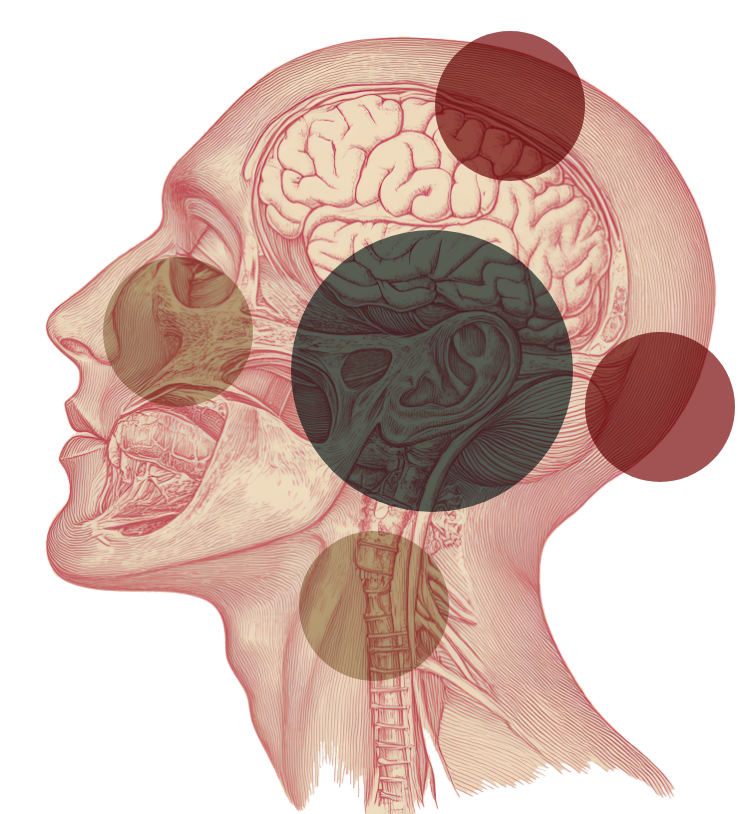Patients’ information
Nose & Sinuses
Chronic sinusitis and its complications (intracranial / intraorbital)

Sinusitis with or without nasal polyps
The paranasal sinuses are cavities in the skull around the nose that contain air. They connect to the inside of the nose through small openings (ostia). The commonly known maxillary sinuses are just one pair of the paranasal sinuses and are located behind the cheeks; they are important for breathing through the nose and for the flow of mucus within the nose and pharynx.
When the paranasal sinuses function normally, no problems occur. However, when they do not function properly, they can cause inflammation with specific symptoms. These infections are called sinusitis or rhinosinusitis and often, in their chronic form, are accompanied by the development of inflammatory polyps. This usually manifests as nasal congestion, pressure and pain in the face, and nasal discharge. It can also cause headaches and partial or complete loss of smell (anosmia), as well as general symptoms such as fatigue, sleep difficulties, and overall malaise. Diagnosing sinusitis can be challenging, so a careful examination is required, which usually includes endoscopic evaluation. Chronic rhinosinusitis is often associated with symptoms from the lower respiratory tract (asthma), allergic predisposition, eczema, or aspirin sensitivity.
Most patients with acute sinusitis recover relatively quickly. In chronic sinusitis or when symptoms persist, medical treatment with antibiotics, nasal drops and sprays, or nasal rinses is required. If symptoms do not improve with conservative treatment, surgery may be necessary.
More rarely, sinusitis can cause complications as the inflammation or polyps may extend toward the eye or brain. These complications, due to their severity, necessitate urgent surgical intervention.
What is FESS (Functional Endoscopic Sinus Surgery)?
FESS, or functional endoscopic sinus surgery, is performed when sinusitis cannot be managed solely with medication. In the past, surgery was done via external incisions on the face and mouth. Today, the use of endoscopes allows the procedure to be done through the nose without external incisions. The procedure is only one part of the overall treatment, which always includes long-term conservative management with nasal rinses and topical treatment.
Before surgery, the patient must undergo medical treatment (drops, sprays, pills) for several weeks or longer. Diagnostic and surgical evaluation also requires a CT scan.
What does the surgery involve?
The surgery is performed under general anesthesia. Using endoscopes, the maxillary sinuses are opened from inside the nose, without any external incision, and depending on the severity and extent of the disease, the ethmoid air cells are removed, and the sphenoid and frontal sinuses are opened. In cases of more extensive disease or recurrences, as well as in patients with Samter’s triad (nasal polyps, asthma, and aspirin sensitivity), more extensive endoscopic procedures may be indicated (Draf 3, endoscopic middle maxillectomy). The goal of the surgery in every case is to improve sinus drainage, address the inflammation, remove polyps (if present), and facilitate further conservative treatment (nasal rinses with topical medication).
What happens after surgery?
We usually do not use nasal packing (gauze inside the nose), so nothing needs to be removed after surgery. The procedure is not particularly painful, and most patients use simple painkillers like paracetamol only for a few days postoperatively. There are no external signs from the surgery (swelling/bruising) since the entire procedure is done endoscopically. However, it is normal for the patient to feel nasal congestion immediately after surgery and for a few days until the mucus and swelling subside.
It is important not to blow your nose for 48 hours after surgery and to avoid strenuous exercise and heavy lifting for several weeks after surgery. Frequent nasal rinses (5-6 times a day) postoperatively are key, as they help healing, prevent infections, and help open and clear the nose from mucus. You may notice some blood and mucus from your nose for a few days after surgery, but this is normal. It is advisable to avoid dust and smoke during recovery.
How long should I stay off work?
Usually, hospital stay is one night after surgery. Afterwards, you will need about a week of recovery at home. If you have a manual labor job, you will need 2 weeks off work.
When can I travel by airplane?
Generally, we recommend patients avoid air travel for seven to ten days after surgery, as dryness and pressure changes may cause problems. However, the exact period is individualized depending on the patient.